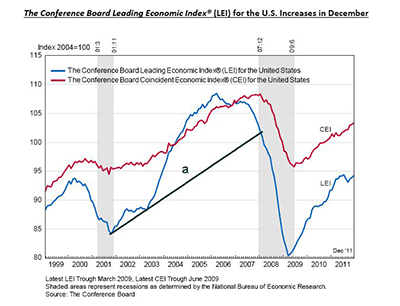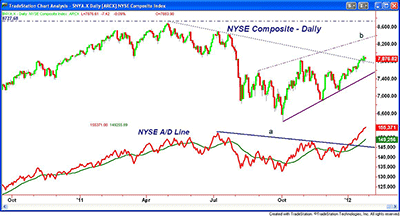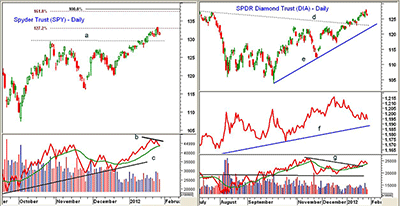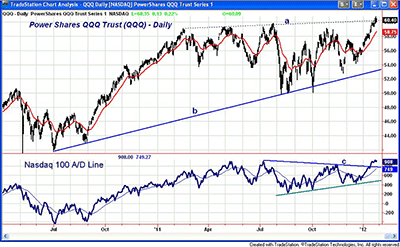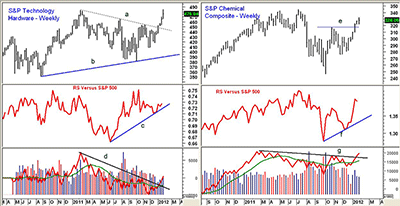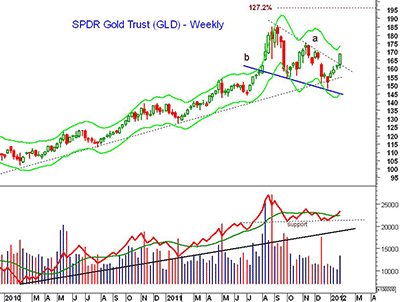Markets are due for a bull-scaring correction that would open more opportunities, but until then investors should stick with lower-risk sectors and good entry levels. MoneyShow.com senior editor Tom Aspray shares his favorite plays.
The US stock market finally took a rest Friday. Investors were disappointed by the advance reading on US GDP for the fourth quarter.
Although the reading of 2.8% was better than the third quarter’s 1.8%, the difference was mainly due to inventory growth. Looking further inside the report, consumer spending was weaker than expected, and so was the consumer savings rate.
This helps to explain Ben Bernanke’s lack of enthusiasm about the economy. The Fed’s announcement that it is planning to keep rates low until year-end 2014, instead of the middle of 2013, gave stocks quite a boost. The Fed also announced a target rate for inflation.
Of course, in extending its outlook, the Fed left open the possibility that rates could be raised before then if conditions warranted. Count on it.
The combination of the Fed announcement and Apple’s (AAPL) surprise earnings have helped to postpone the market’s correction. Many late buyers were sucked in on Thursday’s opening, when the market surged to brief new highs before turning lower.
Frankly, to create a better buying opportunity, the stock market needs more bad news. Why?
Although the number of bulls has stayed fairly constant recently, the number of bears from the American Association of Individual Investors survey has dropped from 23.6% to 18.9%. The market would be healthier if this enthusiasm was dampened.
As stocks have continued to move higher, there has been quite a bit of sector rotation. I expect this to continue, and investors will need to pay close attention to sectors when they establish new positions.
Even though the GDP report disappointed investors, as did Ford’s (F) earnings, there were several bright spots. On Friday, the latest reading on consumer sentiment from the University of Michigan/Thomson Reuters reported its fifth consecutive monthly gain.
The Conference Board reported Thursday that the LEI, their index of ten leading indicators, rose 0.2%. Only three of the components were negative.
The chart of the LEI shows a very nice uptrend from the 2008 lows. The uptrend in the LEI (line a) was broken in early 2008. Also plotted is their Coincident Economic Index (CEI), which has continued to make higher highs since bottoming in 2009.
Of course, the wild card for the US economy remains the Euro debt crisis, and the impact it may have on the global economy. The IMF early last week lowered its forecast for global growth based on the “sharply escalating” risks from Europe.
Talks between Greece and its creditors stalled early last week, but by Friday they were reportedly close to a deal on writing down their debt.
Other Eurozone news was quite mixed, with Spanish unemployment rising to 22%, while consumer sentiment in Germany appears to be optimistic. Late Friday, Fitch downgraded five Eurozone countries: Italy, Spain, Belgium, Cyprus, and Slovenia.
Next week, there is a fairly full slate of economic news, culminating with the monthly jobs report on Friday. On tap for Monday is the data on personal income and outlays, along with the Dallas Fed Manufacturing Survey.
The Tuesday, we have the Employment Cost Index , the S&P Case-Shiller Housing Price Index, the Chicago PMI, and consumer confidence. Worse than expected numbers on housing could trigger some profit taking in this sector.
On Wednesday, we get an advance reading on the job market with the ADP Employment Report, as well as the ISM Manufacturing Index, which can also move the markets. Thursday brings jobless claims and the latest reading on productivity and costs.
Finally, in addition to the jobs report Friday, we also have the factory orders and the ISM Non-Manufacturing Index.
|pagebreak|WHAT TO WATCH
For the intermediate term, last week was positive for the stock market, as it does suggest that any decline will be well supported. We could get an “air pocket” or a sharply lower opening one of these days, in reaction to either Eurozone news or economic data.
The dismal year-to-year performance of many hedge funds last year suggests they did not participate in the rally in the stock market last quarter. Reports suggest they are still not invested, as many do not trust the volume because of the low volume. As shown on a regular basis, the on-balance volume (OBV) has given some good signals, as it identifies the underlying demand.
This chart of the NYSE Composite shows that while this very broad market average is still well below the 2011 high of 8,728, the NYSE Advance/Decline line has already made new highs.
The A/D line broke through its downtrend (line a) at the start of the year, and continues a very strong uptrend. The next major chart target (line b) is about 5% above current levels.
S&P 500
The daily chart of the Spyder Trust (SPY) below shows that it exceeded the 127.2% retracement target at $133.26, as Thursday’s high was $133.40. (In this week’s Trading Lesson, I discussed how these targets are calculated, and gave long-term targets for SPY, GLD, QQQ, and AAPL.)
The same methods can be used on the daily data, as the 127.2% target was calculated using the late October high to the late November low. The “extension” (100% target) is at $138.20, and this is the level where the rally from the October lows would equal the rally in October.
There is first good support at $129.50 (line a), with stronger levels in the $126.50 to $127.50 area. This is about 3% below current levels.
The OBV formed a short-term negative divergence (line b) at Thursday’s highs, which is consistent with a further correction. The S&P 500 A/D line (not shown) has also surpassed its recent highs.
Dow Industrials
The SPDR Diamonds Trust (DIA) exceeded the July highs at $127.30 last week, and came quite close to the April 2011 highs at $128.63.
The daily chart has converging support (lines d and e) in the $122.50 to $121.50 area.
The relative performance, or RS analysis, has been declining since the end of December, as DIA started to underperform the S&P 500.
The OBV has not confirmed the recent highs, and could re-test its breakout level on a further correction.
NEXT: Nasdaq, Sector Focus, and Tom’s Outlook
|pagebreak|Russell 2000
The iShares Russell 2000 Index Fund (IWM) has come very close to the next major resistance in the $80 area, as it was higher Friday. There is longer-term resistance at $84.30, which was the July high.
The relative performance has broken out to the upside, indicating that small caps are starting to outperform the large-cap S&P 500 stocks. The daily OBV has also confirmed the price action.
There is now first good support at $77, which was the breakout level, with stronger support at $75.50.
Nasdaq-100
The PowerShares QQQ Trust (QQQ) closed last week higher after staging a major breakout the prior week. The next upside target is the 127.2% Fibonacci retracement target at $61.06.
The Nasdaq-100 A/D line has also broken through resistance (line c) and is acting quite strong.
QQQ has first good support in the $58 to $59 area, with the rising 20-day EMA at $58.74. The long term uptrend (line b) is in the $53.50 area.
Sector Focus
The iShares Dow Jones Transportation ETF (IYT) was strong again last week, as the resistance in the $94.70 area was finally overcome. There is still longer-term resistance in the $98 area.
The first good support sits in the $91 to $92 area.
Last week’s sector ETF winners were the Select Sector SPDR Technology (XLK) and Select Sector SPDR Materials (XLB). I focused on steel stocks last week.
In these sectors, there are some industry groups that stand out. The S&P Technology Hardware group, which includes Apple, has surged through its downtrend, and the RS line is in an uptrend. The OBV has broken its downtrend (line c) as volume in this sector has picked up recently.
The Chemical stocks also are looking attractive, as the S&P Chemical Composite has moved sharply higher in the past three weeks, and the RS analysis indicates these stocks are acting stronger than the S&P 500. The weekly OBV is also acting stronger than prices after moving through its resistance (line g).
NEXT: Oil, Gold, and Tom’s Outlook
|pagebreak|Oil
The April crude contract closed the week a bit higher, but was almost $2 below the highs. The daily chart still looks toppy, but prices are holding up well.
The support at $98.25 was broken during the week, as it dropped to $97.71 before rebounding. There is stronger support at $95.34, with major levels lingering in the $93.15 area.
The heavy volume over the past few weeks has reinforced the negative signal from the OBV mentioned last week. Remember that the seasonal pattern is for crude to bottom in February.
Strong resistance can be found in the $101.80 to $102.45 zone.
Precious Metals
Two weeks ago, I discussed two scenarios for how the SPDR Gold Trust (GLD) might complete its bottom. Instead of the decline I was expecting, GLD has rallied sharply all week, gaining over 4%.
As I said then, “The bullish scenario is for a rally to the $168 to $170 area, which would be followed by a pullback to the $158 to $160 area or lower. That should present a good buying opportunity."
The weekly chart shows the completion of the flag formation (lines a and b), which has upside targets in the $196 area. The weekly Starc+ band is now in the $173.50 area.
The weekly OBV has moved well above its flat WMA, consistent with the end of the correction. Initial support sits at last week’s opening price of $162.35, with further levels in the $158 to $160 area.
The iShares Silver Trust (SLV) has also been impressive, as it looks ready to challenge the next resistance in the $34 area. This caught me by surprise, but I would advise against chasing it.
The Week Ahead
Stocks tried to correct on Friday in reaction to the GDP data, but rebounded from the worst levels. The Nasdaq closed higher, while the S&P 500 and the Dow Industrials were lower.
These are clearly very resilient markets, as those who have just turned bullish in the past month are chasing prices. I continue to recommend patience for those who are not in stocks, as my initial upside targets have been hit.
The risk in buying the ETFs that track the major averages is high, as stops need to be wide and the odds of a sharp downdraft are still elevated. We could easily see another 200-point down day in the Dow to shake out the late buyers.
Therefore, I would only look to buy stocks where the risk can be well controlled. Clearly I like the material sector (chemicals and steel), as well as technology hardware. Biotech has had a great run, but the risk control in this sector is often difficult.
I still would wait for the red-hot sectors, like homebuilders and regional banks, to come back to important support before buying. Those stocks that are correcting now may be the leaders once the market averages finally correct.
I would suggest that if you have nice profits in individual stocks, use further market strength to take some profits. This will allow you to raise cash for further opportunities down the road.
Gold is another tough one, as my recommended buy level at $148.20 was missed by 7 cents. We should still see a correction in the next week or so that will provide a better entry, even if prices stay higher.
- Don’t miss Tom’s latest Trading Lesson: Predicting Price Targets with Fibonacci

